Optimizing Logistics Operations for Efficient Transportation
VerifiedAdded on 2019/11/26
|12
|3096
|163
Report
AI Summary
APL Logistics is a global logistics company that has identified the importance of different technologies to foster growth in the industry. The company has implemented various strategies to improve its operations, including using Internet of Things (IoT) technology to enhance efficiency and reduce costs. The use of IoT has also enabled APL to track shipments more effectively, reducing transit times and increasing customer satisfaction. Additionally, the company has emphasized the importance of supply chain management and purchasing decisions in achieving sustainability and reducing environmental impact.
Contribute Materials
Your contribution can guide someone’s learning journey. Share your
documents today.

Running head: APL LOGISTICS, SINGAPORE
Purchasing Management
[APL Logistics, Singapore]
Name of the student:
Name of the university:
Author note:
Purchasing Management
[APL Logistics, Singapore]
Name of the student:
Name of the university:
Author note:
Secure Best Marks with AI Grader
Need help grading? Try our AI Grader for instant feedback on your assignments.
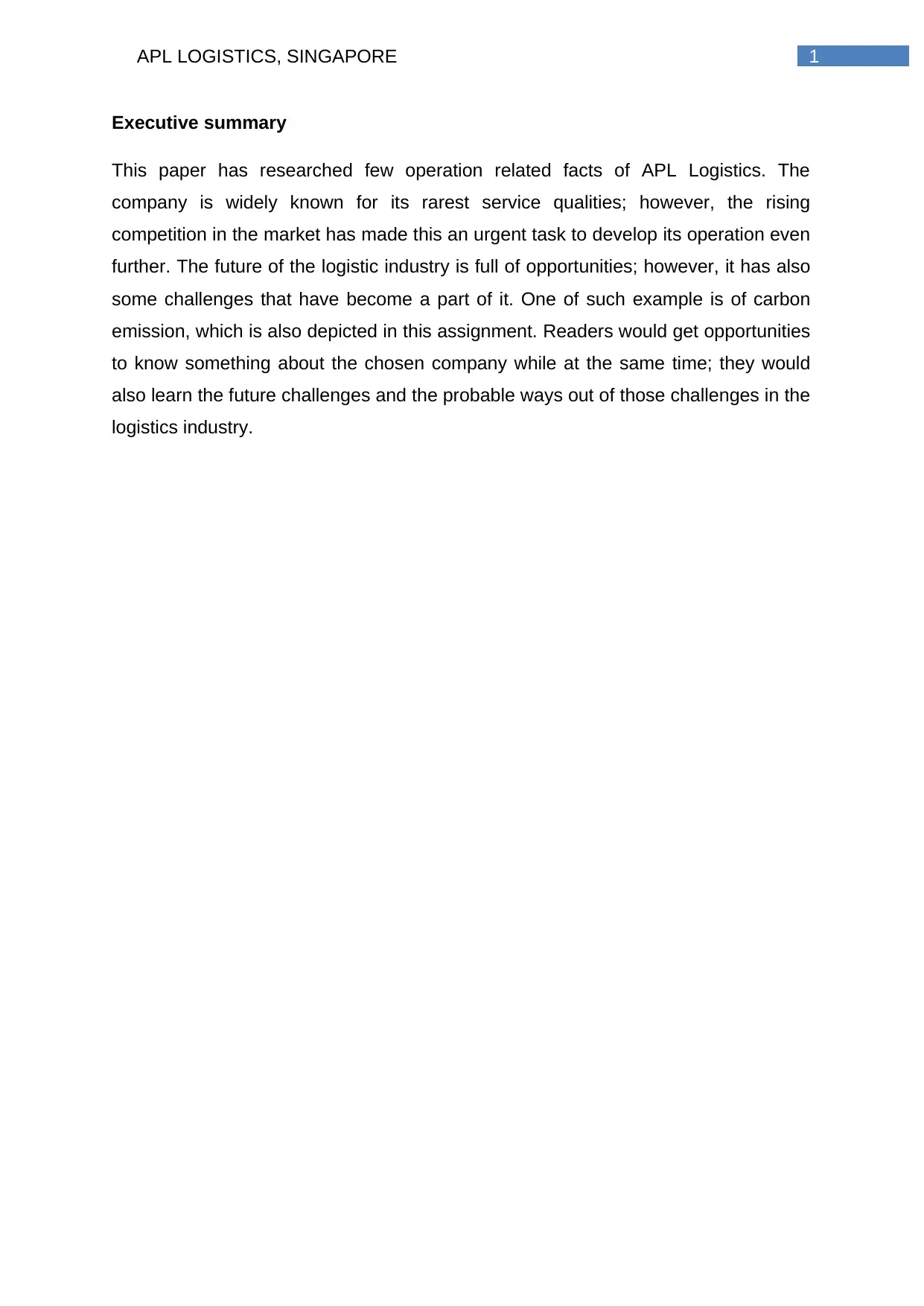
1APL LOGISTICS, SINGAPORE
Executive summary
This paper has researched few operation related facts of APL Logistics. The
company is widely known for its rarest service qualities; however, the rising
competition in the market has made this an urgent task to develop its operation even
further. The future of the logistic industry is full of opportunities; however, it has also
some challenges that have become a part of it. One of such example is of carbon
emission, which is also depicted in this assignment. Readers would get opportunities
to know something about the chosen company while at the same time; they would
also learn the future challenges and the probable ways out of those challenges in the
logistics industry.
Executive summary
This paper has researched few operation related facts of APL Logistics. The
company is widely known for its rarest service qualities; however, the rising
competition in the market has made this an urgent task to develop its operation even
further. The future of the logistic industry is full of opportunities; however, it has also
some challenges that have become a part of it. One of such example is of carbon
emission, which is also depicted in this assignment. Readers would get opportunities
to know something about the chosen company while at the same time; they would
also learn the future challenges and the probable ways out of those challenges in the
logistics industry.
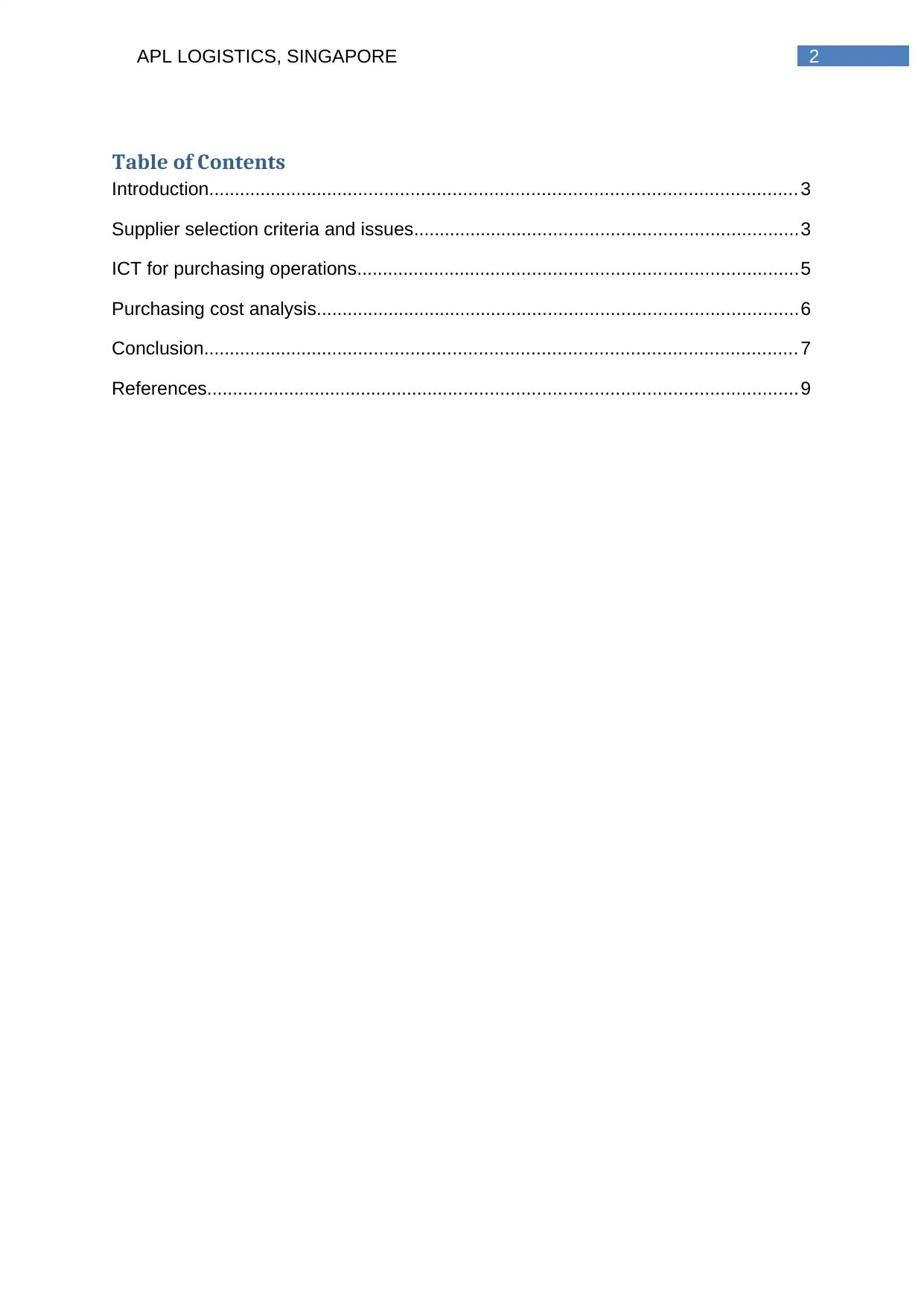
2APL LOGISTICS, SINGAPORE
Table of Contents
Introduction................................................................................................................. 3
Supplier selection criteria and issues..........................................................................3
ICT for purchasing operations.....................................................................................5
Purchasing cost analysis.............................................................................................6
Conclusion.................................................................................................................. 7
References..................................................................................................................9
Table of Contents
Introduction................................................................................................................. 3
Supplier selection criteria and issues..........................................................................3
ICT for purchasing operations.....................................................................................5
Purchasing cost analysis.............................................................................................6
Conclusion.................................................................................................................. 7
References..................................................................................................................9

3APL LOGISTICS, SINGAPORE
Introduction
Purchasing is the first stage, which an organisation perform to initiate the
business. It is both related to buying the products or the services. Purchasing
involves various strategic planning in it, which in fact produces the final purchasing.
On a same note, purchasing management is a process through which companies
manage their purchasing and set standards for such process. It is highly important to
have a good relationship in between the service provider and its supplier. A good
interrelationship means a sound exchange of each other’s capabilities, which
collectively serves the different purposes of customers. Nevertheless, a purposeful
business can only sustain a long existence in the market (Giunipero, Hooker &
Denslow, 2012).
The selected organisation for this assignment is APL Logistics Ltd., which is a
wholly owned subsidiary of a Japanese Company Kintetsu World Express, Inc.
(KWE). The company is operating in most parts of world and providing solutions on
logistic services. It provides its services to many different industries such as
automotive, retail, consumer and industrials verticals. Its competitors are Orient
Overseas (International) Limited, Nippon Yusen Kabushiki Kaisha and Maersk A/S.
The operational goal is to grow with the existing & the new customers and to
establish it as a developed company in the different targeted verticals
(Apllogistics.com, 2017). They have succeeded to leave a huge impact on the global
logistic industry with their continuous rising market shares. Some of their strategies
such as smarter policies for procurement, flexibility with external infrastructure etc
have publicised their global presence (edb.gov.sg, 2017).
The main purpose of this assignment is to analyse the effectiveness of the
purchasing management of the APL Logistics in Singapore. The three aspects,
which this assignment would focus on are the selection criteria for suppliers, costs of
purchasing and Use of ICT in managing the purchasing.
Supplier selection criteria and issues
The supplier selection criteria of the APL Logistics revolve around becoming
global with wide range of potential industries. Currently, it has suppliers from four
Introduction
Purchasing is the first stage, which an organisation perform to initiate the
business. It is both related to buying the products or the services. Purchasing
involves various strategic planning in it, which in fact produces the final purchasing.
On a same note, purchasing management is a process through which companies
manage their purchasing and set standards for such process. It is highly important to
have a good relationship in between the service provider and its supplier. A good
interrelationship means a sound exchange of each other’s capabilities, which
collectively serves the different purposes of customers. Nevertheless, a purposeful
business can only sustain a long existence in the market (Giunipero, Hooker &
Denslow, 2012).
The selected organisation for this assignment is APL Logistics Ltd., which is a
wholly owned subsidiary of a Japanese Company Kintetsu World Express, Inc.
(KWE). The company is operating in most parts of world and providing solutions on
logistic services. It provides its services to many different industries such as
automotive, retail, consumer and industrials verticals. Its competitors are Orient
Overseas (International) Limited, Nippon Yusen Kabushiki Kaisha and Maersk A/S.
The operational goal is to grow with the existing & the new customers and to
establish it as a developed company in the different targeted verticals
(Apllogistics.com, 2017). They have succeeded to leave a huge impact on the global
logistic industry with their continuous rising market shares. Some of their strategies
such as smarter policies for procurement, flexibility with external infrastructure etc
have publicised their global presence (edb.gov.sg, 2017).
The main purpose of this assignment is to analyse the effectiveness of the
purchasing management of the APL Logistics in Singapore. The three aspects,
which this assignment would focus on are the selection criteria for suppliers, costs of
purchasing and Use of ICT in managing the purchasing.
Supplier selection criteria and issues
The supplier selection criteria of the APL Logistics revolve around becoming
global with wide range of potential industries. Currently, it has suppliers from four
Secure Best Marks with AI Grader
Need help grading? Try our AI Grader for instant feedback on your assignments.
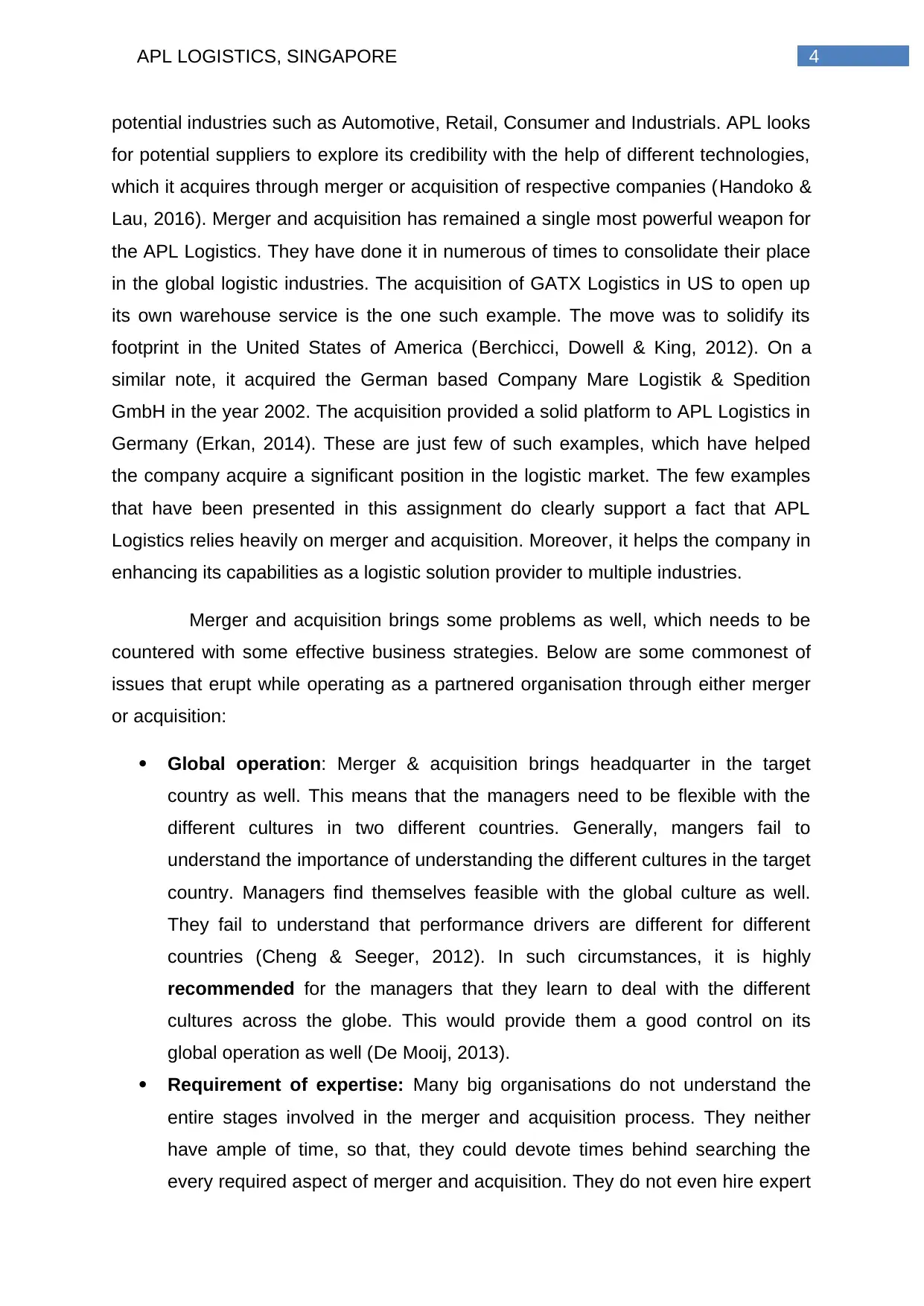
4APL LOGISTICS, SINGAPORE
potential industries such as Automotive, Retail, Consumer and Industrials. APL looks
for potential suppliers to explore its credibility with the help of different technologies,
which it acquires through merger or acquisition of respective companies (Handoko &
Lau, 2016). Merger and acquisition has remained a single most powerful weapon for
the APL Logistics. They have done it in numerous of times to consolidate their place
in the global logistic industries. The acquisition of GATX Logistics in US to open up
its own warehouse service is the one such example. The move was to solidify its
footprint in the United States of America (Berchicci, Dowell & King, 2012). On a
similar note, it acquired the German based Company Mare Logistik & Spedition
GmbH in the year 2002. The acquisition provided a solid platform to APL Logistics in
Germany (Erkan, 2014). These are just few of such examples, which have helped
the company acquire a significant position in the logistic market. The few examples
that have been presented in this assignment do clearly support a fact that APL
Logistics relies heavily on merger and acquisition. Moreover, it helps the company in
enhancing its capabilities as a logistic solution provider to multiple industries.
Merger and acquisition brings some problems as well, which needs to be
countered with some effective business strategies. Below are some commonest of
issues that erupt while operating as a partnered organisation through either merger
or acquisition:
Global operation: Merger & acquisition brings headquarter in the target
country as well. This means that the managers need to be flexible with the
different cultures in two different countries. Generally, mangers fail to
understand the importance of understanding the different cultures in the target
country. Managers find themselves feasible with the global culture as well.
They fail to understand that performance drivers are different for different
countries (Cheng & Seeger, 2012). In such circumstances, it is highly
recommended for the managers that they learn to deal with the different
cultures across the globe. This would provide them a good control on its
global operation as well (De Mooij, 2013).
Requirement of expertise: Many big organisations do not understand the
entire stages involved in the merger and acquisition process. They neither
have ample of time, so that, they could devote times behind searching the
every required aspect of merger and acquisition. They do not even hire expert
potential industries such as Automotive, Retail, Consumer and Industrials. APL looks
for potential suppliers to explore its credibility with the help of different technologies,
which it acquires through merger or acquisition of respective companies (Handoko &
Lau, 2016). Merger and acquisition has remained a single most powerful weapon for
the APL Logistics. They have done it in numerous of times to consolidate their place
in the global logistic industries. The acquisition of GATX Logistics in US to open up
its own warehouse service is the one such example. The move was to solidify its
footprint in the United States of America (Berchicci, Dowell & King, 2012). On a
similar note, it acquired the German based Company Mare Logistik & Spedition
GmbH in the year 2002. The acquisition provided a solid platform to APL Logistics in
Germany (Erkan, 2014). These are just few of such examples, which have helped
the company acquire a significant position in the logistic market. The few examples
that have been presented in this assignment do clearly support a fact that APL
Logistics relies heavily on merger and acquisition. Moreover, it helps the company in
enhancing its capabilities as a logistic solution provider to multiple industries.
Merger and acquisition brings some problems as well, which needs to be
countered with some effective business strategies. Below are some commonest of
issues that erupt while operating as a partnered organisation through either merger
or acquisition:
Global operation: Merger & acquisition brings headquarter in the target
country as well. This means that the managers need to be flexible with the
different cultures in two different countries. Generally, mangers fail to
understand the importance of understanding the different cultures in the target
country. Managers find themselves feasible with the global culture as well.
They fail to understand that performance drivers are different for different
countries (Cheng & Seeger, 2012). In such circumstances, it is highly
recommended for the managers that they learn to deal with the different
cultures across the globe. This would provide them a good control on its
global operation as well (De Mooij, 2013).
Requirement of expertise: Many big organisations do not understand the
entire stages involved in the merger and acquisition process. They neither
have ample of time, so that, they could devote times behind searching the
every required aspect of merger and acquisition. They do not even hire expert
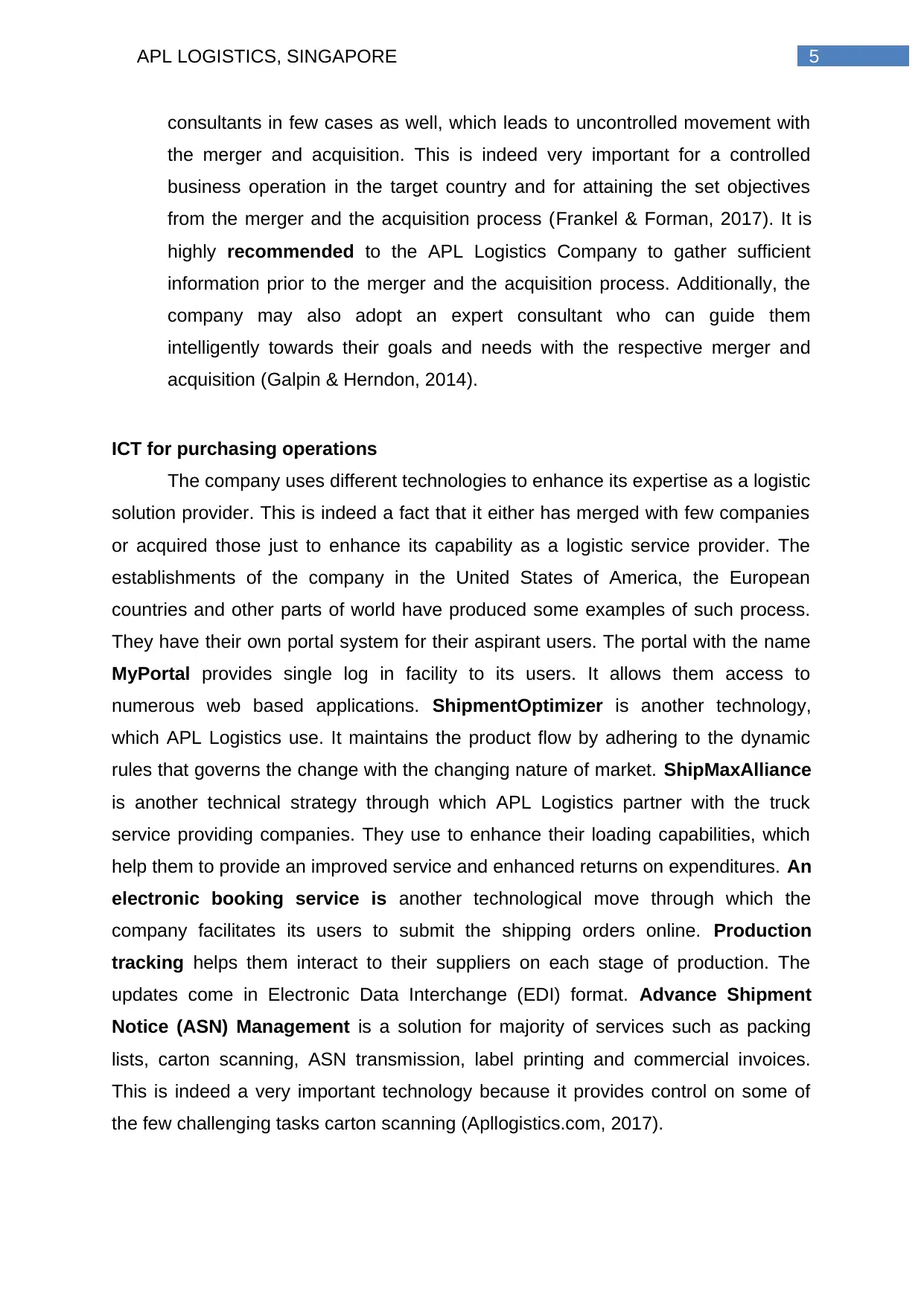
5APL LOGISTICS, SINGAPORE
consultants in few cases as well, which leads to uncontrolled movement with
the merger and acquisition. This is indeed very important for a controlled
business operation in the target country and for attaining the set objectives
from the merger and the acquisition process (Frankel & Forman, 2017). It is
highly recommended to the APL Logistics Company to gather sufficient
information prior to the merger and the acquisition process. Additionally, the
company may also adopt an expert consultant who can guide them
intelligently towards their goals and needs with the respective merger and
acquisition (Galpin & Herndon, 2014).
ICT for purchasing operations
The company uses different technologies to enhance its expertise as a logistic
solution provider. This is indeed a fact that it either has merged with few companies
or acquired those just to enhance its capability as a logistic service provider. The
establishments of the company in the United States of America, the European
countries and other parts of world have produced some examples of such process.
They have their own portal system for their aspirant users. The portal with the name
MyPortal provides single log in facility to its users. It allows them access to
numerous web based applications. ShipmentOptimizer is another technology,
which APL Logistics use. It maintains the product flow by adhering to the dynamic
rules that governs the change with the changing nature of market. ShipMaxAlliance
is another technical strategy through which APL Logistics partner with the truck
service providing companies. They use to enhance their loading capabilities, which
help them to provide an improved service and enhanced returns on expenditures. An
electronic booking service is another technological move through which the
company facilitates its users to submit the shipping orders online. Production
tracking helps them interact to their suppliers on each stage of production. The
updates come in Electronic Data Interchange (EDI) format. Advance Shipment
Notice (ASN) Management is a solution for majority of services such as packing
lists, carton scanning, ASN transmission, label printing and commercial invoices.
This is indeed a very important technology because it provides control on some of
the few challenging tasks carton scanning (Apllogistics.com, 2017).
consultants in few cases as well, which leads to uncontrolled movement with
the merger and acquisition. This is indeed very important for a controlled
business operation in the target country and for attaining the set objectives
from the merger and the acquisition process (Frankel & Forman, 2017). It is
highly recommended to the APL Logistics Company to gather sufficient
information prior to the merger and the acquisition process. Additionally, the
company may also adopt an expert consultant who can guide them
intelligently towards their goals and needs with the respective merger and
acquisition (Galpin & Herndon, 2014).
ICT for purchasing operations
The company uses different technologies to enhance its expertise as a logistic
solution provider. This is indeed a fact that it either has merged with few companies
or acquired those just to enhance its capability as a logistic service provider. The
establishments of the company in the United States of America, the European
countries and other parts of world have produced some examples of such process.
They have their own portal system for their aspirant users. The portal with the name
MyPortal provides single log in facility to its users. It allows them access to
numerous web based applications. ShipmentOptimizer is another technology,
which APL Logistics use. It maintains the product flow by adhering to the dynamic
rules that governs the change with the changing nature of market. ShipMaxAlliance
is another technical strategy through which APL Logistics partner with the truck
service providing companies. They use to enhance their loading capabilities, which
help them to provide an improved service and enhanced returns on expenditures. An
electronic booking service is another technological move through which the
company facilitates its users to submit the shipping orders online. Production
tracking helps them interact to their suppliers on each stage of production. The
updates come in Electronic Data Interchange (EDI) format. Advance Shipment
Notice (ASN) Management is a solution for majority of services such as packing
lists, carton scanning, ASN transmission, label printing and commercial invoices.
This is indeed a very important technology because it provides control on some of
the few challenging tasks carton scanning (Apllogistics.com, 2017).
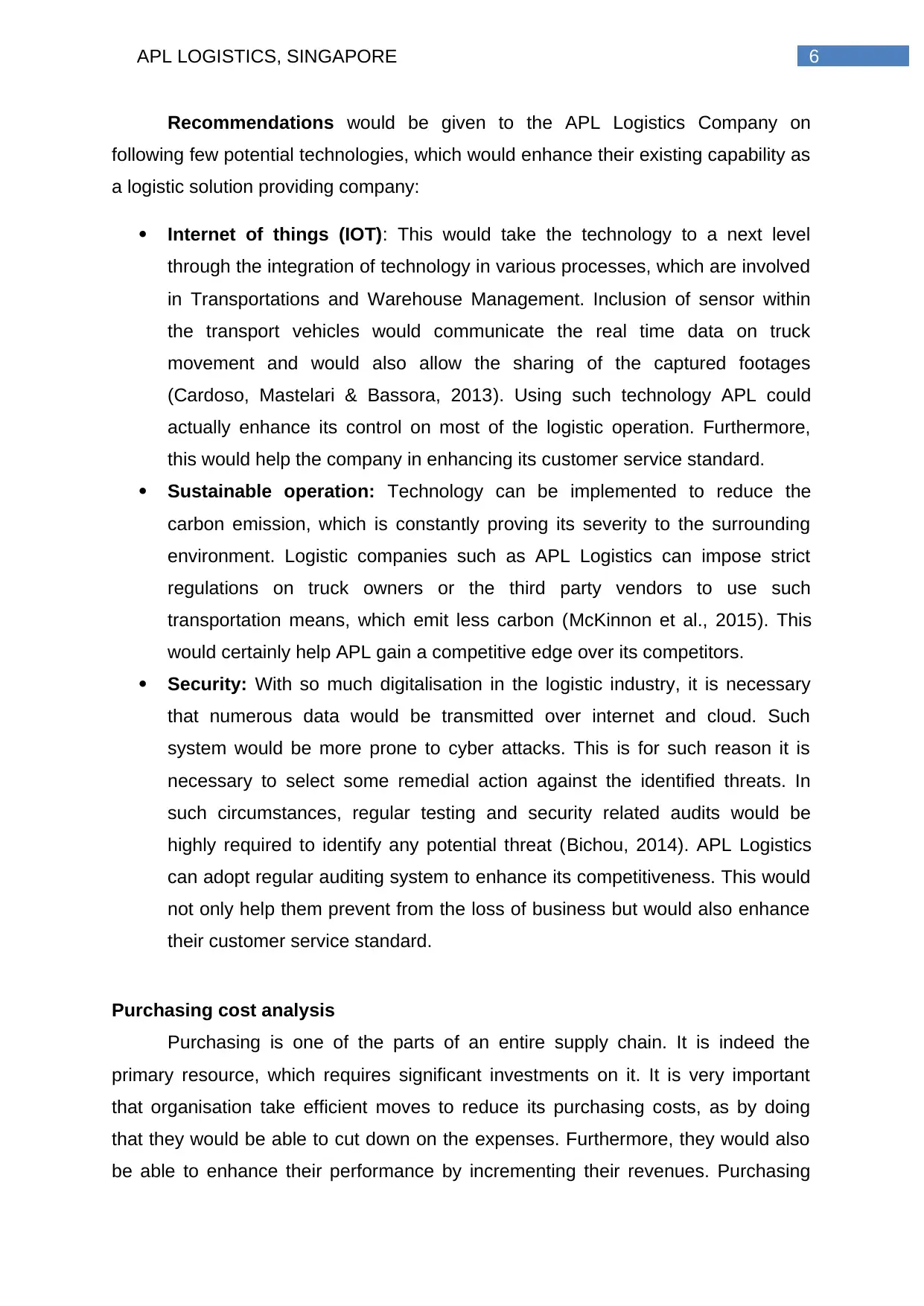
6APL LOGISTICS, SINGAPORE
Recommendations would be given to the APL Logistics Company on
following few potential technologies, which would enhance their existing capability as
a logistic solution providing company:
Internet of things (IOT): This would take the technology to a next level
through the integration of technology in various processes, which are involved
in Transportations and Warehouse Management. Inclusion of sensor within
the transport vehicles would communicate the real time data on truck
movement and would also allow the sharing of the captured footages
(Cardoso, Mastelari & Bassora, 2013). Using such technology APL could
actually enhance its control on most of the logistic operation. Furthermore,
this would help the company in enhancing its customer service standard.
Sustainable operation: Technology can be implemented to reduce the
carbon emission, which is constantly proving its severity to the surrounding
environment. Logistic companies such as APL Logistics can impose strict
regulations on truck owners or the third party vendors to use such
transportation means, which emit less carbon (McKinnon et al., 2015). This
would certainly help APL gain a competitive edge over its competitors.
Security: With so much digitalisation in the logistic industry, it is necessary
that numerous data would be transmitted over internet and cloud. Such
system would be more prone to cyber attacks. This is for such reason it is
necessary to select some remedial action against the identified threats. In
such circumstances, regular testing and security related audits would be
highly required to identify any potential threat (Bichou, 2014). APL Logistics
can adopt regular auditing system to enhance its competitiveness. This would
not only help them prevent from the loss of business but would also enhance
their customer service standard.
Purchasing cost analysis
Purchasing is one of the parts of an entire supply chain. It is indeed the
primary resource, which requires significant investments on it. It is very important
that organisation take efficient moves to reduce its purchasing costs, as by doing
that they would be able to cut down on the expenses. Furthermore, they would also
be able to enhance their performance by incrementing their revenues. Purchasing
Recommendations would be given to the APL Logistics Company on
following few potential technologies, which would enhance their existing capability as
a logistic solution providing company:
Internet of things (IOT): This would take the technology to a next level
through the integration of technology in various processes, which are involved
in Transportations and Warehouse Management. Inclusion of sensor within
the transport vehicles would communicate the real time data on truck
movement and would also allow the sharing of the captured footages
(Cardoso, Mastelari & Bassora, 2013). Using such technology APL could
actually enhance its control on most of the logistic operation. Furthermore,
this would help the company in enhancing its customer service standard.
Sustainable operation: Technology can be implemented to reduce the
carbon emission, which is constantly proving its severity to the surrounding
environment. Logistic companies such as APL Logistics can impose strict
regulations on truck owners or the third party vendors to use such
transportation means, which emit less carbon (McKinnon et al., 2015). This
would certainly help APL gain a competitive edge over its competitors.
Security: With so much digitalisation in the logistic industry, it is necessary
that numerous data would be transmitted over internet and cloud. Such
system would be more prone to cyber attacks. This is for such reason it is
necessary to select some remedial action against the identified threats. In
such circumstances, regular testing and security related audits would be
highly required to identify any potential threat (Bichou, 2014). APL Logistics
can adopt regular auditing system to enhance its competitiveness. This would
not only help them prevent from the loss of business but would also enhance
their customer service standard.
Purchasing cost analysis
Purchasing is one of the parts of an entire supply chain. It is indeed the
primary resource, which requires significant investments on it. It is very important
that organisation take efficient moves to reduce its purchasing costs, as by doing
that they would be able to cut down on the expenses. Furthermore, they would also
be able to enhance their performance by incrementing their revenues. Purchasing
Paraphrase This Document
Need a fresh take? Get an instant paraphrase of this document with our AI Paraphraser
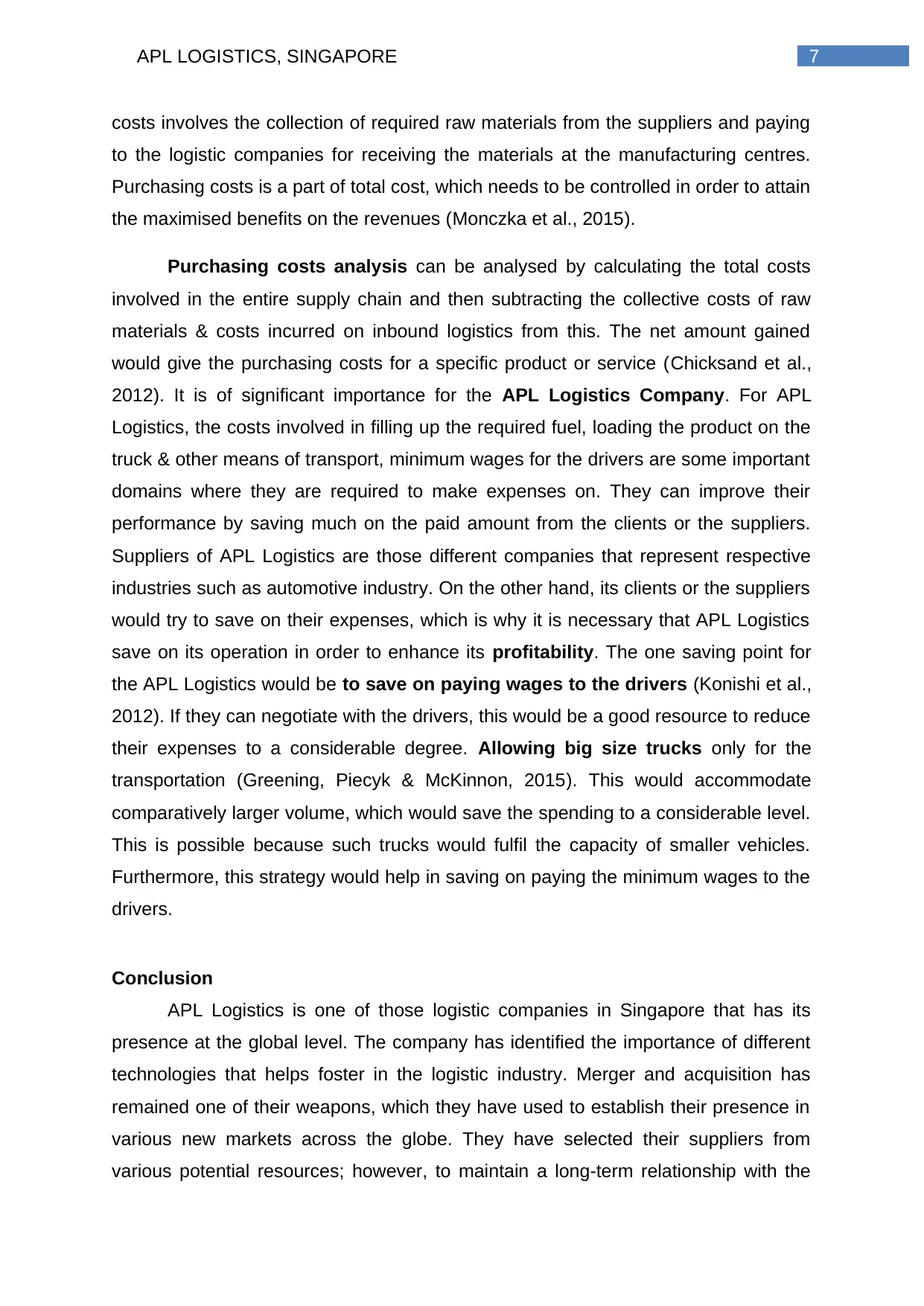
7APL LOGISTICS, SINGAPORE
costs involves the collection of required raw materials from the suppliers and paying
to the logistic companies for receiving the materials at the manufacturing centres.
Purchasing costs is a part of total cost, which needs to be controlled in order to attain
the maximised benefits on the revenues (Monczka et al., 2015).
Purchasing costs analysis can be analysed by calculating the total costs
involved in the entire supply chain and then subtracting the collective costs of raw
materials & costs incurred on inbound logistics from this. The net amount gained
would give the purchasing costs for a specific product or service (Chicksand et al.,
2012). It is of significant importance for the APL Logistics Company. For APL
Logistics, the costs involved in filling up the required fuel, loading the product on the
truck & other means of transport, minimum wages for the drivers are some important
domains where they are required to make expenses on. They can improve their
performance by saving much on the paid amount from the clients or the suppliers.
Suppliers of APL Logistics are those different companies that represent respective
industries such as automotive industry. On the other hand, its clients or the suppliers
would try to save on their expenses, which is why it is necessary that APL Logistics
save on its operation in order to enhance its profitability. The one saving point for
the APL Logistics would be to save on paying wages to the drivers (Konishi et al.,
2012). If they can negotiate with the drivers, this would be a good resource to reduce
their expenses to a considerable degree. Allowing big size trucks only for the
transportation (Greening, Piecyk & McKinnon, 2015). This would accommodate
comparatively larger volume, which would save the spending to a considerable level.
This is possible because such trucks would fulfil the capacity of smaller vehicles.
Furthermore, this strategy would help in saving on paying the minimum wages to the
drivers.
Conclusion
APL Logistics is one of those logistic companies in Singapore that has its
presence at the global level. The company has identified the importance of different
technologies that helps foster in the logistic industry. Merger and acquisition has
remained one of their weapons, which they have used to establish their presence in
various new markets across the globe. They have selected their suppliers from
various potential resources; however, to maintain a long-term relationship with the
costs involves the collection of required raw materials from the suppliers and paying
to the logistic companies for receiving the materials at the manufacturing centres.
Purchasing costs is a part of total cost, which needs to be controlled in order to attain
the maximised benefits on the revenues (Monczka et al., 2015).
Purchasing costs analysis can be analysed by calculating the total costs
involved in the entire supply chain and then subtracting the collective costs of raw
materials & costs incurred on inbound logistics from this. The net amount gained
would give the purchasing costs for a specific product or service (Chicksand et al.,
2012). It is of significant importance for the APL Logistics Company. For APL
Logistics, the costs involved in filling up the required fuel, loading the product on the
truck & other means of transport, minimum wages for the drivers are some important
domains where they are required to make expenses on. They can improve their
performance by saving much on the paid amount from the clients or the suppliers.
Suppliers of APL Logistics are those different companies that represent respective
industries such as automotive industry. On the other hand, its clients or the suppliers
would try to save on their expenses, which is why it is necessary that APL Logistics
save on its operation in order to enhance its profitability. The one saving point for
the APL Logistics would be to save on paying wages to the drivers (Konishi et al.,
2012). If they can negotiate with the drivers, this would be a good resource to reduce
their expenses to a considerable degree. Allowing big size trucks only for the
transportation (Greening, Piecyk & McKinnon, 2015). This would accommodate
comparatively larger volume, which would save the spending to a considerable level.
This is possible because such trucks would fulfil the capacity of smaller vehicles.
Furthermore, this strategy would help in saving on paying the minimum wages to the
drivers.
Conclusion
APL Logistics is one of those logistic companies in Singapore that has its
presence at the global level. The company has identified the importance of different
technologies that helps foster in the logistic industry. Merger and acquisition has
remained one of their weapons, which they have used to establish their presence in
various new markets across the globe. They have selected their suppliers from
various potential resources; however, to maintain a long-term relationship with the
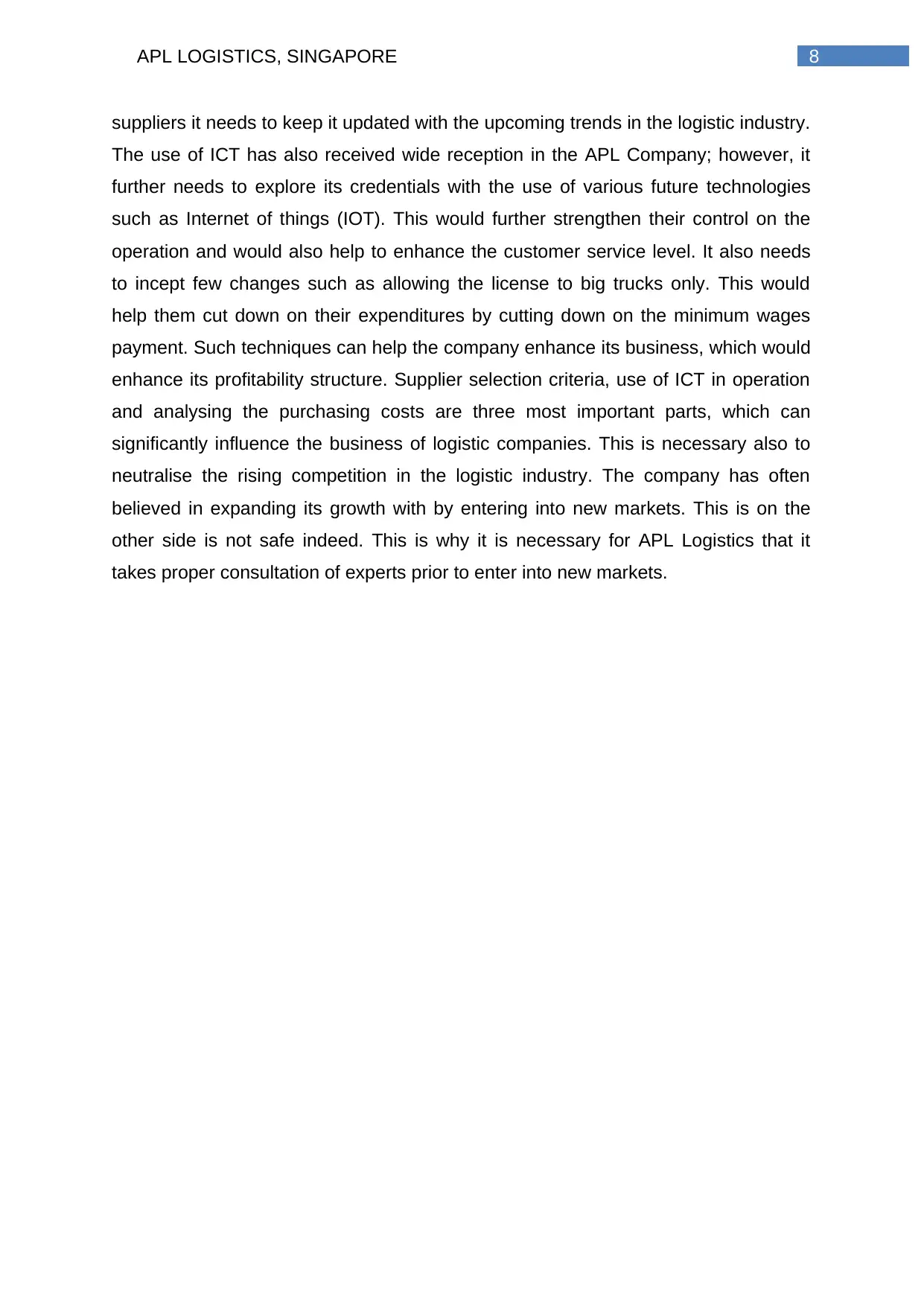
8APL LOGISTICS, SINGAPORE
suppliers it needs to keep it updated with the upcoming trends in the logistic industry.
The use of ICT has also received wide reception in the APL Company; however, it
further needs to explore its credentials with the use of various future technologies
such as Internet of things (IOT). This would further strengthen their control on the
operation and would also help to enhance the customer service level. It also needs
to incept few changes such as allowing the license to big trucks only. This would
help them cut down on their expenditures by cutting down on the minimum wages
payment. Such techniques can help the company enhance its business, which would
enhance its profitability structure. Supplier selection criteria, use of ICT in operation
and analysing the purchasing costs are three most important parts, which can
significantly influence the business of logistic companies. This is necessary also to
neutralise the rising competition in the logistic industry. The company has often
believed in expanding its growth with by entering into new markets. This is on the
other side is not safe indeed. This is why it is necessary for APL Logistics that it
takes proper consultation of experts prior to enter into new markets.
suppliers it needs to keep it updated with the upcoming trends in the logistic industry.
The use of ICT has also received wide reception in the APL Company; however, it
further needs to explore its credentials with the use of various future technologies
such as Internet of things (IOT). This would further strengthen their control on the
operation and would also help to enhance the customer service level. It also needs
to incept few changes such as allowing the license to big trucks only. This would
help them cut down on their expenditures by cutting down on the minimum wages
payment. Such techniques can help the company enhance its business, which would
enhance its profitability structure. Supplier selection criteria, use of ICT in operation
and analysing the purchasing costs are three most important parts, which can
significantly influence the business of logistic companies. This is necessary also to
neutralise the rising competition in the logistic industry. The company has often
believed in expanding its growth with by entering into new markets. This is on the
other side is not safe indeed. This is why it is necessary for APL Logistics that it
takes proper consultation of experts prior to enter into new markets.
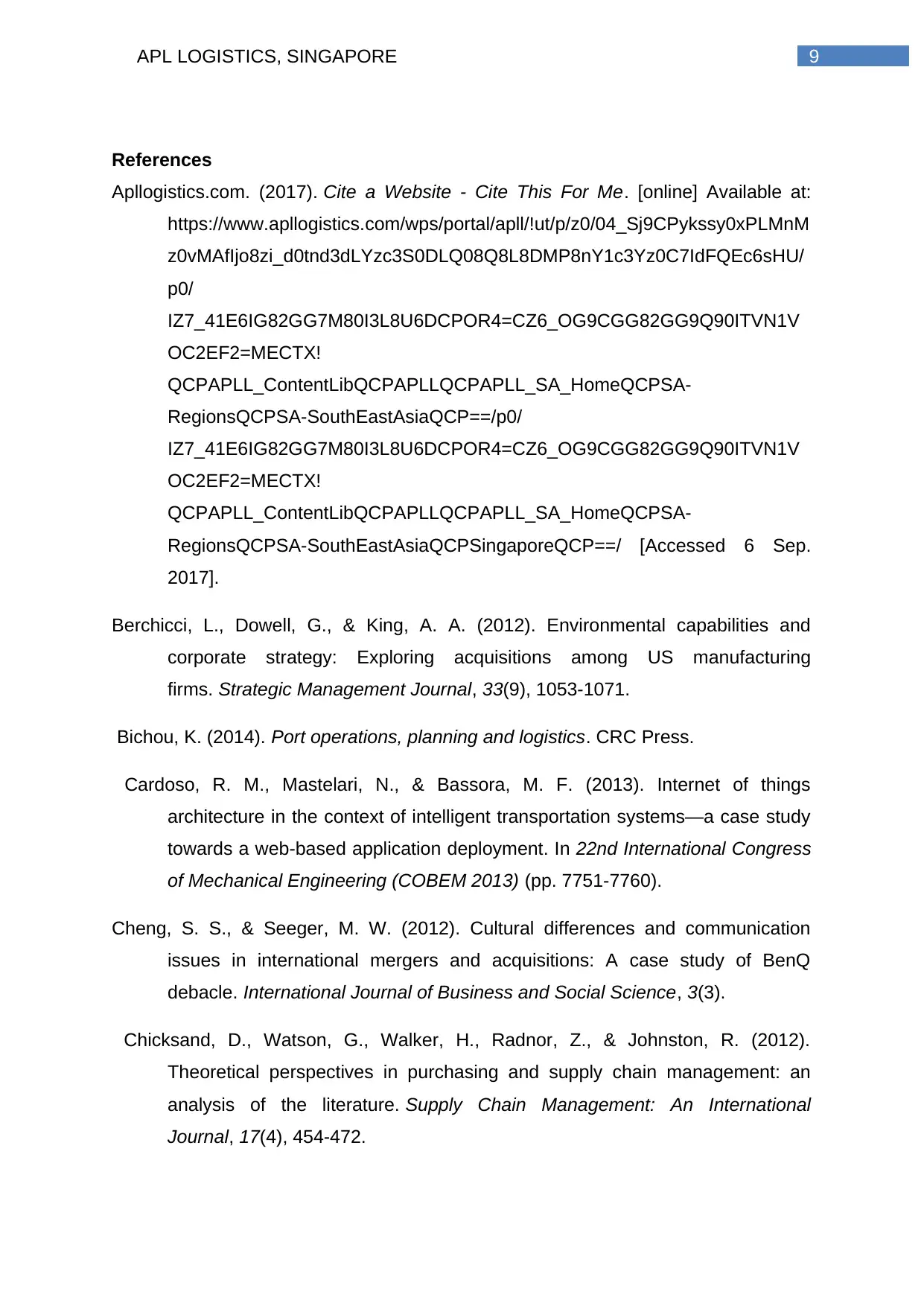
9APL LOGISTICS, SINGAPORE
References
Apllogistics.com. (2017). Cite a Website - Cite This For Me. [online] Available at:
https://www.apllogistics.com/wps/portal/apll/!ut/p/z0/04_Sj9CPykssy0xPLMnM
z0vMAfIjo8zi_d0tnd3dLYzc3S0DLQ08Q8L8DMP8nY1c3Yz0C7IdFQEc6sHU/
p0/
IZ7_41E6IG82GG7M80I3L8U6DCPOR4=CZ6_OG9CGG82GG9Q90ITVN1V
OC2EF2=MECTX!
QCPAPLL_ContentLibQCPAPLLQCPAPLL_SA_HomeQCPSA-
RegionsQCPSA-SouthEastAsiaQCP==/p0/
IZ7_41E6IG82GG7M80I3L8U6DCPOR4=CZ6_OG9CGG82GG9Q90ITVN1V
OC2EF2=MECTX!
QCPAPLL_ContentLibQCPAPLLQCPAPLL_SA_HomeQCPSA-
RegionsQCPSA-SouthEastAsiaQCPSingaporeQCP==/ [Accessed 6 Sep.
2017].
Berchicci, L., Dowell, G., & King, A. A. (2012). Environmental capabilities and
corporate strategy: Exploring acquisitions among US manufacturing
firms. Strategic Management Journal, 33(9), 1053-1071.
Bichou, K. (2014). Port operations, planning and logistics. CRC Press.
Cardoso, R. M., Mastelari, N., & Bassora, M. F. (2013). Internet of things
architecture in the context of intelligent transportation systems—a case study
towards a web-based application deployment. In 22nd International Congress
of Mechanical Engineering (COBEM 2013) (pp. 7751-7760).
Cheng, S. S., & Seeger, M. W. (2012). Cultural differences and communication
issues in international mergers and acquisitions: A case study of BenQ
debacle. International Journal of Business and Social Science, 3(3).
Chicksand, D., Watson, G., Walker, H., Radnor, Z., & Johnston, R. (2012).
Theoretical perspectives in purchasing and supply chain management: an
analysis of the literature. Supply Chain Management: An International
Journal, 17(4), 454-472.
References
Apllogistics.com. (2017). Cite a Website - Cite This For Me. [online] Available at:
https://www.apllogistics.com/wps/portal/apll/!ut/p/z0/04_Sj9CPykssy0xPLMnM
z0vMAfIjo8zi_d0tnd3dLYzc3S0DLQ08Q8L8DMP8nY1c3Yz0C7IdFQEc6sHU/
p0/
IZ7_41E6IG82GG7M80I3L8U6DCPOR4=CZ6_OG9CGG82GG9Q90ITVN1V
OC2EF2=MECTX!
QCPAPLL_ContentLibQCPAPLLQCPAPLL_SA_HomeQCPSA-
RegionsQCPSA-SouthEastAsiaQCP==/p0/
IZ7_41E6IG82GG7M80I3L8U6DCPOR4=CZ6_OG9CGG82GG9Q90ITVN1V
OC2EF2=MECTX!
QCPAPLL_ContentLibQCPAPLLQCPAPLL_SA_HomeQCPSA-
RegionsQCPSA-SouthEastAsiaQCPSingaporeQCP==/ [Accessed 6 Sep.
2017].
Berchicci, L., Dowell, G., & King, A. A. (2012). Environmental capabilities and
corporate strategy: Exploring acquisitions among US manufacturing
firms. Strategic Management Journal, 33(9), 1053-1071.
Bichou, K. (2014). Port operations, planning and logistics. CRC Press.
Cardoso, R. M., Mastelari, N., & Bassora, M. F. (2013). Internet of things
architecture in the context of intelligent transportation systems—a case study
towards a web-based application deployment. In 22nd International Congress
of Mechanical Engineering (COBEM 2013) (pp. 7751-7760).
Cheng, S. S., & Seeger, M. W. (2012). Cultural differences and communication
issues in international mergers and acquisitions: A case study of BenQ
debacle. International Journal of Business and Social Science, 3(3).
Chicksand, D., Watson, G., Walker, H., Radnor, Z., & Johnston, R. (2012).
Theoretical perspectives in purchasing and supply chain management: an
analysis of the literature. Supply Chain Management: An International
Journal, 17(4), 454-472.
Secure Best Marks with AI Grader
Need help grading? Try our AI Grader for instant feedback on your assignments.
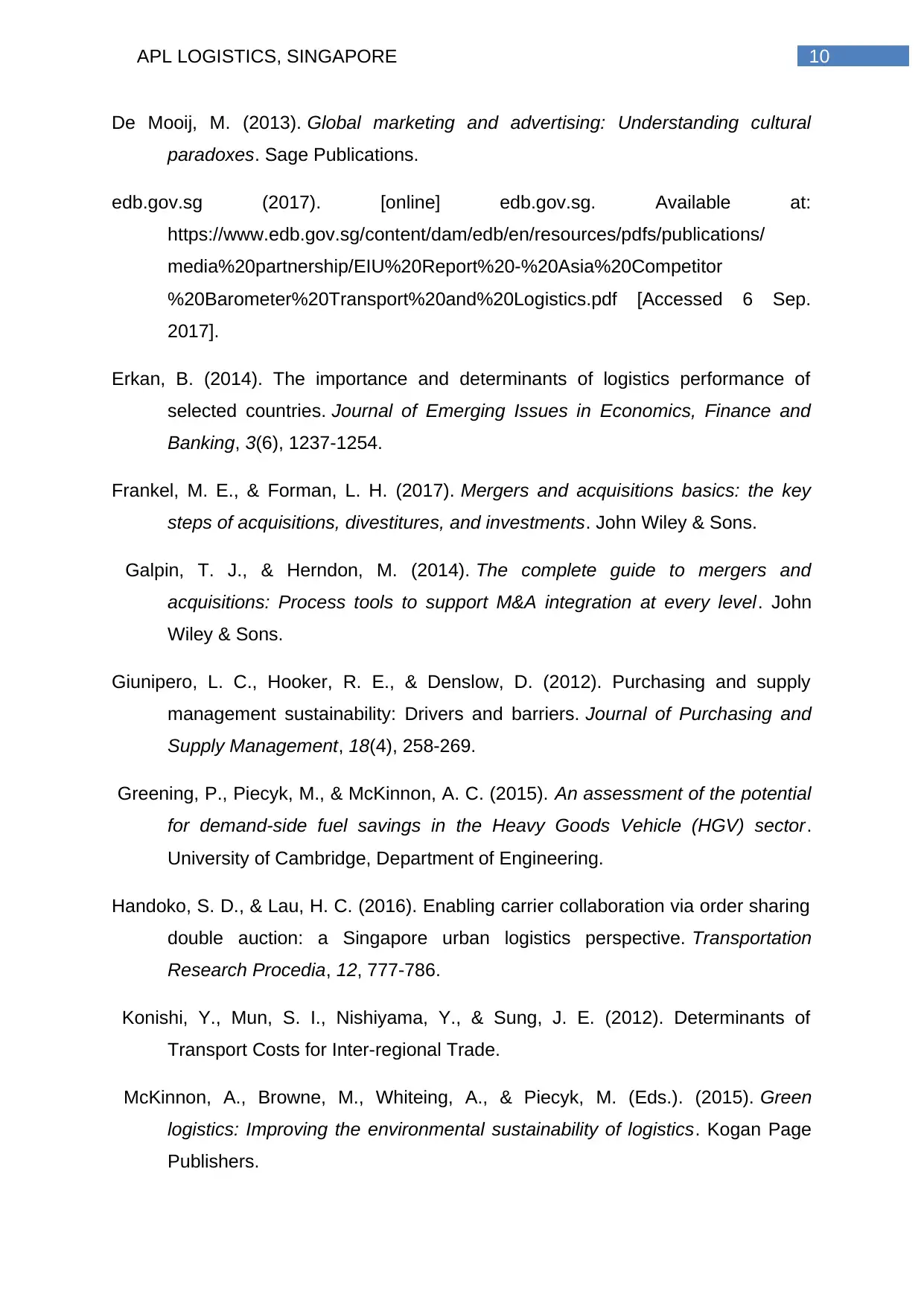
10APL LOGISTICS, SINGAPORE
De Mooij, M. (2013). Global marketing and advertising: Understanding cultural
paradoxes. Sage Publications.
edb.gov.sg (2017). [online] edb.gov.sg. Available at:
https://www.edb.gov.sg/content/dam/edb/en/resources/pdfs/publications/
media%20partnership/EIU%20Report%20-%20Asia%20Competitor
%20Barometer%20Transport%20and%20Logistics.pdf [Accessed 6 Sep.
2017].
Erkan, B. (2014). The importance and determinants of logistics performance of
selected countries. Journal of Emerging Issues in Economics, Finance and
Banking, 3(6), 1237-1254.
Frankel, M. E., & Forman, L. H. (2017). Mergers and acquisitions basics: the key
steps of acquisitions, divestitures, and investments. John Wiley & Sons.
Galpin, T. J., & Herndon, M. (2014). The complete guide to mergers and
acquisitions: Process tools to support M&A integration at every level. John
Wiley & Sons.
Giunipero, L. C., Hooker, R. E., & Denslow, D. (2012). Purchasing and supply
management sustainability: Drivers and barriers. Journal of Purchasing and
Supply Management, 18(4), 258-269.
Greening, P., Piecyk, M., & McKinnon, A. C. (2015). An assessment of the potential
for demand-side fuel savings in the Heavy Goods Vehicle (HGV) sector.
University of Cambridge, Department of Engineering.
Handoko, S. D., & Lau, H. C. (2016). Enabling carrier collaboration via order sharing
double auction: a Singapore urban logistics perspective. Transportation
Research Procedia, 12, 777-786.
Konishi, Y., Mun, S. I., Nishiyama, Y., & Sung, J. E. (2012). Determinants of
Transport Costs for Inter-regional Trade.
McKinnon, A., Browne, M., Whiteing, A., & Piecyk, M. (Eds.). (2015). Green
logistics: Improving the environmental sustainability of logistics. Kogan Page
Publishers.
De Mooij, M. (2013). Global marketing and advertising: Understanding cultural
paradoxes. Sage Publications.
edb.gov.sg (2017). [online] edb.gov.sg. Available at:
https://www.edb.gov.sg/content/dam/edb/en/resources/pdfs/publications/
media%20partnership/EIU%20Report%20-%20Asia%20Competitor
%20Barometer%20Transport%20and%20Logistics.pdf [Accessed 6 Sep.
2017].
Erkan, B. (2014). The importance and determinants of logistics performance of
selected countries. Journal of Emerging Issues in Economics, Finance and
Banking, 3(6), 1237-1254.
Frankel, M. E., & Forman, L. H. (2017). Mergers and acquisitions basics: the key
steps of acquisitions, divestitures, and investments. John Wiley & Sons.
Galpin, T. J., & Herndon, M. (2014). The complete guide to mergers and
acquisitions: Process tools to support M&A integration at every level. John
Wiley & Sons.
Giunipero, L. C., Hooker, R. E., & Denslow, D. (2012). Purchasing and supply
management sustainability: Drivers and barriers. Journal of Purchasing and
Supply Management, 18(4), 258-269.
Greening, P., Piecyk, M., & McKinnon, A. C. (2015). An assessment of the potential
for demand-side fuel savings in the Heavy Goods Vehicle (HGV) sector.
University of Cambridge, Department of Engineering.
Handoko, S. D., & Lau, H. C. (2016). Enabling carrier collaboration via order sharing
double auction: a Singapore urban logistics perspective. Transportation
Research Procedia, 12, 777-786.
Konishi, Y., Mun, S. I., Nishiyama, Y., & Sung, J. E. (2012). Determinants of
Transport Costs for Inter-regional Trade.
McKinnon, A., Browne, M., Whiteing, A., & Piecyk, M. (Eds.). (2015). Green
logistics: Improving the environmental sustainability of logistics. Kogan Page
Publishers.
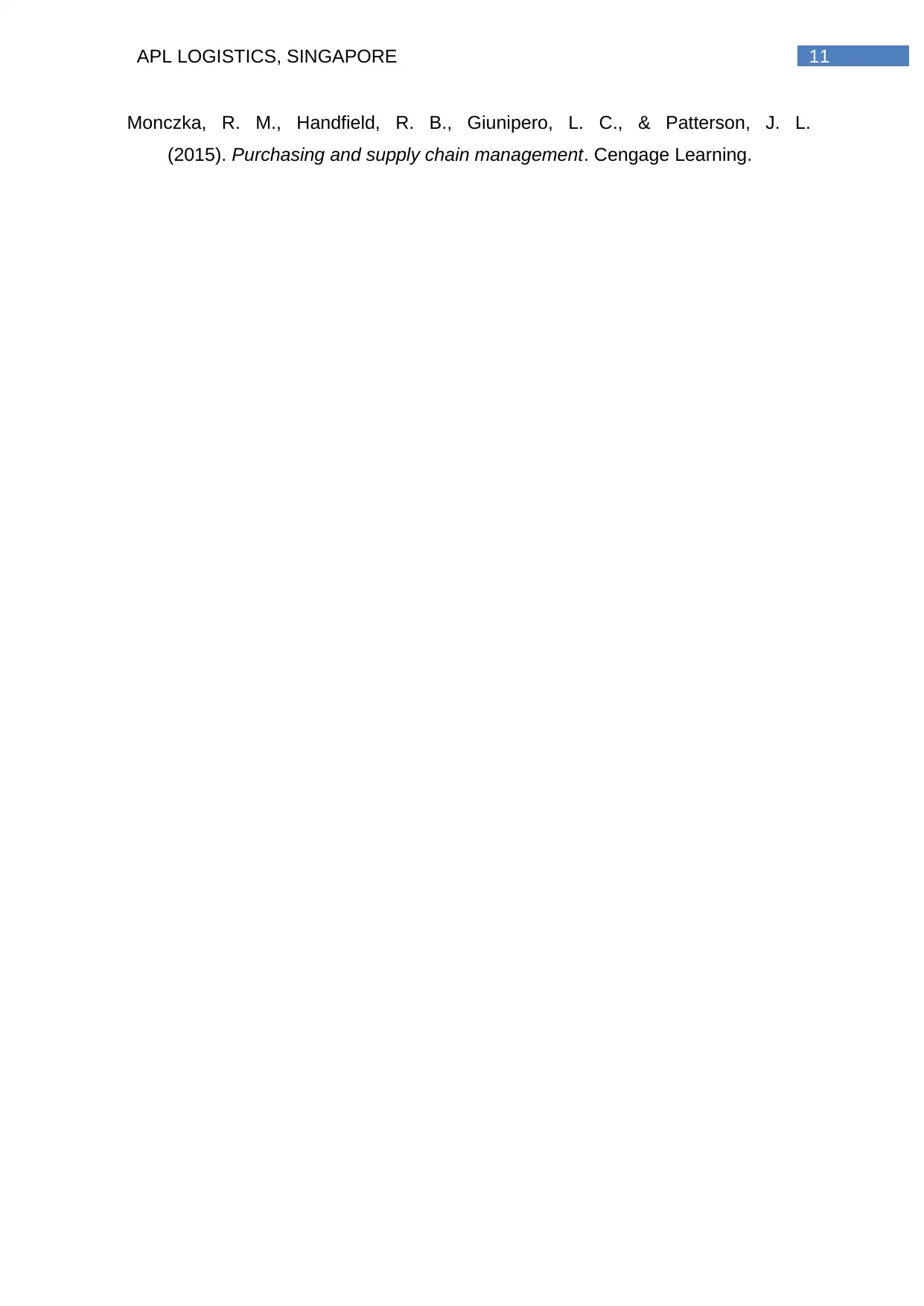
11APL LOGISTICS, SINGAPORE
Monczka, R. M., Handfield, R. B., Giunipero, L. C., & Patterson, J. L.
(2015). Purchasing and supply chain management. Cengage Learning.
Monczka, R. M., Handfield, R. B., Giunipero, L. C., & Patterson, J. L.
(2015). Purchasing and supply chain management. Cengage Learning.
1 out of 12
Related Documents
Your All-in-One AI-Powered Toolkit for Academic Success.
+13062052269
info@desklib.com
Available 24*7 on WhatsApp / Email
![[object Object]](/_next/static/media/star-bottom.7253800d.svg)
Unlock your academic potential
© 2024 | Zucol Services PVT LTD | All rights reserved.





